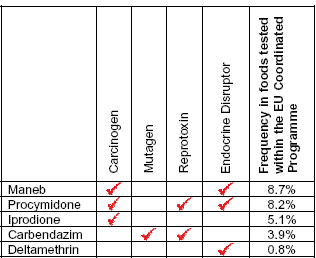Fruits, vegetables and cereals sold throughout the European Union contain record levels of pesticides - according to an official report to be published later this month. Almost half of fruits, vegetables and cereals are now contaminated with pesticides - a substantial increase on the level seen just 5 years ago. Five of the pesticides most common in the food chain are classified as carcinogenic, mutagenic, or disruptive to the hormonal system.
The findings come just days before politicians in Brussels are set to debate new EU pesticide legislation - including a proposal to eliminate the most hazardous pesticides from use in food production. But despite evidence of widespread food contamination, efforts to reduce dietary exposure to hazardous pesticides are being fiercely contested by the pesticides industry.
'These are the worst pesticide results we've ever seen', said Elliott Cannell, Coordinator of PAN Europe. 'A record proportion of fruits and vegetables are contaminated, while 23 pesticides were detected at levels high enough to present an acute risk to public health - according to the EU's own risk calculations.'
'The need to reduce exposure to hazardous pesticides is more urgent now than ever. Politicians in Brussels must back the removal of the worst pesticides from the food chain, and ensure that hazardous pesticides are replaced with safer alternatives wherever possible.'
According to an advance copy of the forthcoming EU food monitoring report, seen by PAN Europe:
- Forty nine percent of fruits, vegetables and cereals contain pesticides. This is the highest ever level of pesticide contamination recorded in the EU and represents an increase of around 20% over the past 5 year period.
- In total, 4.7% of fruits, vegetables and cereals contain pesticides at concentrations above maximum legal limits, while over 10% contain 4 or more different pesticide residues.
- Five of the pesticides found most often in food products sold in the European Union are classified as carcinogenic, mutagenic, toxic to reproduction, or disruptive to the hormonal system.

- Twenty three pesticide substances were detected at levels high enough to present an acute risk to public health – according to the EU’s own risk calculations.
- Food products sold in the EU now contain 354 different pesticides – the highest total ever recorded.
- For the first time, imidacloprid – a controversial pesticide banned in France due to links with mass bee deaths – has been listed among the most common pesticide residues in foods.
- Worst affected foods include grapes (71% contaminated), bananas (56% contaminated) and peppers (46% contaminated), while one in 25 aubergines tested contained pesticides above maximum legal limits.
For further comments, please contact:
Elliott Cannell, Coordinator, PAN Europe
-- ENDS --
